Abc coconut tree
Chicka Chicka Boom Boom
None Sing along with this cheerful alphabet race up the coconut tree. A told B, and B told C, and one by one, like energetic kids playing, they race up the coconut tree. Chicka Chicka Boom Boom! Will there be enough room? Sing along as the playful letters make their way up the coconut tree, making it bend from their weight, and . . . BOOM! BOOM! Authors Bill Martin Jr. and John Archambault’s rhythmic lyrics and Caldecott Honor illustrator Lois Ehlert’s bright, bold colors make for a catchy way to remember the alphabet—both lower and uppercase letters. When A wakes up and starts back up the tree . . . what do you think will happen next? show full description Show Short DescriptionClassics
Share your favorite stories with your child. Enjoy classic bedtime stories from your childhood like Chicka Chicka Boom Boom, Chicken Little, Where the Wild Things Are, and Harold and the Purple Crayon.
view all
Chicka Chicka Boom Boom
Harry the Dirty Dog
Wheels on the Bus
Chicken Little
The Snowy Day
The Dot
Where the Wild Things Are
Duck on a Bike
Swimmy
Harold and the Purple Crayon
One membership, two learning apps for ages 2-8.
TRY IT FOR FREE
Full Text
Chicka Chicka Boom Boom Chicka chicka boom boom Chicka chicka boom boom Chicka chicka boom boom Chicka chicka boom boom Chicka chicka boom boom A told B, and B told C, “I’ll meet you at the top of the coconut tree.” “Whee!” said D to E, F, G. “I’ll beat you to the top of the coconut tree.” Chicka chicka boom boom! Will there be enough room? Here comes H up the coconut tree, and I and J and tag-along K, all on their way up the coconut tree. Chicka chicka boom boom! Will there be enough room? Look who’s coming! L, M, N, O, P! And Q, R, S! And T, U, V! Still more—W! And X, Y, Z! The whole alphabet up the—Oh, no! Chicka chicka BOOM! BOOM! Skit skat skoodle doot. Flip flop flee. Everybody running to the coconut tree. Mamas and papas and uncles and aunts hug their little dears, then dust their pants. “Help us up,” cried A, B, C. Next from the pileup skinned-knee D and stubbed-toe E and patched-up F. Then comes G all out of breath. H is tangled up with I. J and K are about to cry. L is knotted like a tie. M is looped. N is stooped. O is twisted alley-oop. Skit skat skoodle doot. Flip flop flee. Look who’s coming! It’s black-eyed P, Q, R, S, and loose-tooth T. Then U, V, W wiggle-jiggle free. Last to come X, Y, Z. And the sun goes down on the coconut tree. But chicka chicka boom boom! Look, there’s a full moon. A is out of bed, and this is what he said, “Dare double dare, you can’t catch me.” Chicka chicka BOOM! BOOM! (Chicka BOOM!) Chicka chicka BOOM! BOOM! (Chicka chicka BOOM! BOOM!) “I’ll beat you to the top of the coconut tree.
Chicka chicka boom boom! Will there be enough room? Look who’s coming! L, M, N, O, P! And Q, R, S! And T, U, V! Still more—W! And X, Y, Z! The whole alphabet up the—Oh, no! Chicka chicka BOOM! BOOM! Skit skat skoodle doot. Flip flop flee. Everybody running to the coconut tree. Mamas and papas and uncles and aunts hug their little dears, then dust their pants. “Help us up,” cried A, B, C. Next from the pileup skinned-knee D and stubbed-toe E and patched-up F. Then comes G all out of breath. H is tangled up with I. J and K are about to cry. L is knotted like a tie. M is looped. N is stooped. O is twisted alley-oop. Skit skat skoodle doot. Flip flop flee. Look who’s coming! It’s black-eyed P, Q, R, S, and loose-tooth T. Then U, V, W wiggle-jiggle free. Last to come X, Y, Z. And the sun goes down on the coconut tree. But chicka chicka boom boom! Look, there’s a full moon. A is out of bed, and this is what he said, “Dare double dare, you can’t catch me.” Chicka chicka BOOM! BOOM! (Chicka BOOM!) Chicka chicka BOOM! BOOM! (Chicka chicka BOOM! BOOM!) “I’ll beat you to the top of the coconut tree.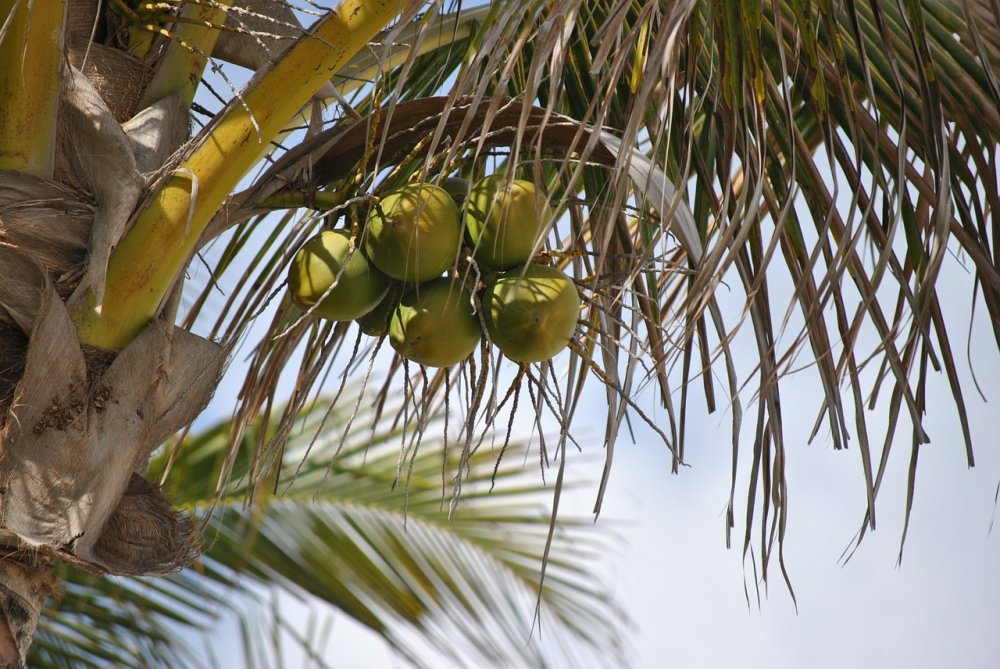 ” Chicka chicka BOOM! BOOM! (Chicka BOOM!) Chicka chicka BOOM! BOOM! (Chicka chicka BOOM! BOOM!) “Dare double dare, you can’t catch me.”
” Chicka chicka BOOM! BOOM! (Chicka BOOM!) Chicka chicka BOOM! BOOM! (Chicka chicka BOOM! BOOM!) “Dare double dare, you can’t catch me.”
1
We take your child's unique passions
2
Add their current reading level
3
And create a personalized learn-to-read plan
4
That teaches them to read and love reading
TRY IT FOR FREE
Chicka Chicka Boom Boom Tree
Etsy is no longer supporting older versions of your web browser in order to ensure that user data remains secure. Please update to the latest version.
Take full advantage of our site features by enabling JavaScript.
Find something memorable, join a community doing good.
(62 relevant results)
Real coconut palms are one of the most capricious.
 Care at home. Photo - Botanichka
Care at home. Photo - Botanichka Real coconut palms, surprising in nature with gigantic sizes and a generous harvest of giant nuts, are considered not the most suitable plants for room culture. But, nevertheless, homemade coconut trees can be found in almost every flower shop, and many hobbyists even grow their own coconut trees from purchased nuts. Whichever way you get the coconut palm, you should prepare for trouble: despite its beauty, it is one of the most difficult (if not the most difficult) palm trees to grow. And only experienced and very attentive flower growers can save it, and even then only for a few years. Care for her will require not just regular, but super-careful.
Home-sprouted coconut palm. © PalmTreeDudeHome version of coconut
There are so many palm trees named coconut on the market today that even experienced growers can get confused. Consultants often tout Weddel coconuts, and other types of palm trees, as an indoor version of the coconut that is compact, beautiful, and hardy.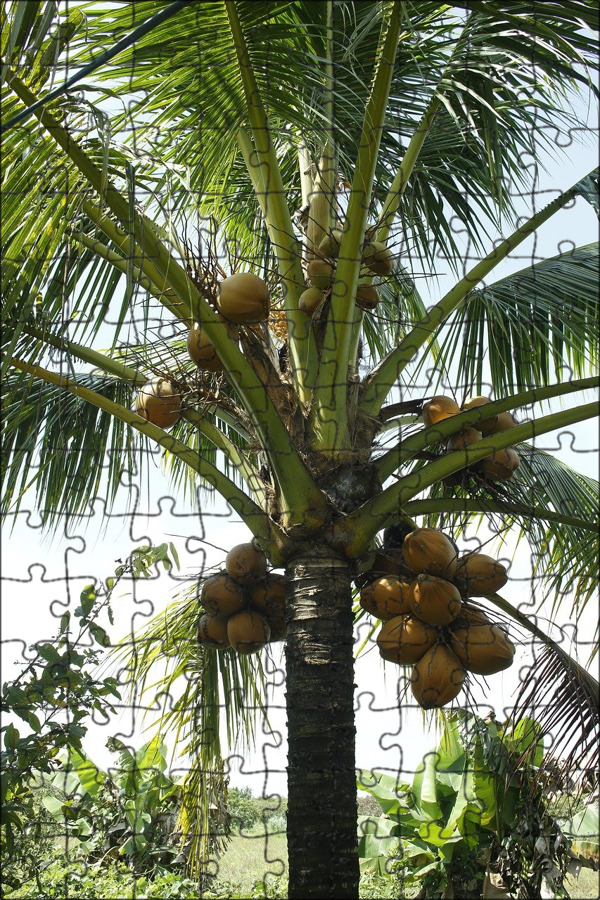 But such pinnate and fan beauties have almost nothing to do with coconut palms. Most often, under the guise of coconuts, we sell lithocarias (
Lytocaryum ) (Weddel's coconut ( Lytocaryum weddellianum ) and other species of the genus) and butia ( Butia ), whose name is still found as a synonym for coconut. They are also not easy to grow palm trees, but they are very far from genuine coconut. Only one type of palm belongs to the genus Cocos - Cocos nucifera . It is simply impossible to confuse this palm tree with any other.
But such pinnate and fan beauties have almost nothing to do with coconut palms. Most often, under the guise of coconuts, we sell lithocarias (
Lytocaryum ) (Weddel's coconut ( Lytocaryum weddellianum ) and other species of the genus) and butia ( Butia ), whose name is still found as a synonym for coconut. They are also not easy to grow palm trees, but they are very far from genuine coconut. Only one type of palm belongs to the genus Cocos - Cocos nucifera . It is simply impossible to confuse this palm tree with any other.
Coconut palm ( Cocos nucifera ) is not only a tropical palm, but also usually found only in coastal areas. Nut-bearing coconuts are classified as feathery palms and are quite large in size. In room conditions and even greenhouses, coconuts can grow up to only 3 meters. But since it is very difficult to keep a palm tree until adulthood, coconuts are limited to much more modest parameters. Considered a fast-growing palm, the coconut develops as a slender, bushy plant with a tall trunk and an asymmetrical crown-top of broad and unevenly pinnate leaves, the number of which in an adult palm can reach up to 35 wai.
The trunk is formed and "stretched" gradually, it has vertical cracks and rings from falling leaves, the expansion at the base is small. The slope of the trunk is determined by the growth of the walnut, it is more or less pronounced. The leaves of the coconut palm change with age. Young they are almost whole, but gradually the cuts on the leaf plates become deeper, and the wide leaves turn into pinnate and long. In indoor coconuts, the leaves are often divided into just a couple of segments. In the coconut palm, the leaf plates and their lobes, like the petioles, are very rigid. The length of the leaves is up to 2 - 3 meters. Flowering of nut-bearing coconut is impossible not only in room conditions, but also in greenhouse conditions.
Coconut palms look very attractive: the contrast between a half-buried nut, from which rises at first a slender and small, and then more and more graceful and interesting palm tree, adds to its decorative effect. Palm nuts are lost at such a significant age that it is almost impossible to wait for this in a room culture.
Coconut palm care at home
It is believed that indoor coconuts can "last" - even with very good selection of conditions and the most careful care - only 2-3 years. This palm is indeed very difficult to grow and is more likely to be planted for experimentation or if you want to test your skills. As a stable ornamental palm tree, it would be a very big mistake to buy coconut nut. Firstly, because of the sun-loving nature, it cannot be placed in the interior. And, secondly, the risk of loss is always higher than the probability of success. But if you want to try, get ready for relentless care.
Growing coconut palm at home in the form of bonsai. © Coco BonsaiLighting for the Coconut Tree
The need to provide the coconut tree with very bright light throughout the year is one of the main difficulties in growing this plant. Nut-bearing coconut is not just a photophilous plant. It needs long daylight hours all year round. And the only lighting option that will suit this palm tree will be a sunny place on the southern windowsill or places with artificial lighting. In winter, lighting is welcome anywhere.
In winter, lighting is welcome anywhere.
Comfortable temperature conditions
This is one of the most heat-loving palm trees, for which the minimum allowable temperatures are limited by the value of short-term drops to 16-17 degrees Celsius. Throughout the year, the coconut tree will prefer the heat over the subdued temperatures. In summer, coconut feels best at a temperature of 23 degrees Celsius, but if the indicators remain above 21 degrees, then there should be no difficulties with the selection of premises.
The coconut tree will need constant access to fresh air, regular ventilation. But it will not be so easy to carry them out with the dislike of palm trees for drafts and sudden changes in the environment.
Coconut Watering and Air Humidity
To maintain your coconut tree, you will need to keep the substrate moist. Even a single drying of an earthen coma, and even more so the lack of stable watering or prolonged drying, can lead to the rapid death of a palm tree.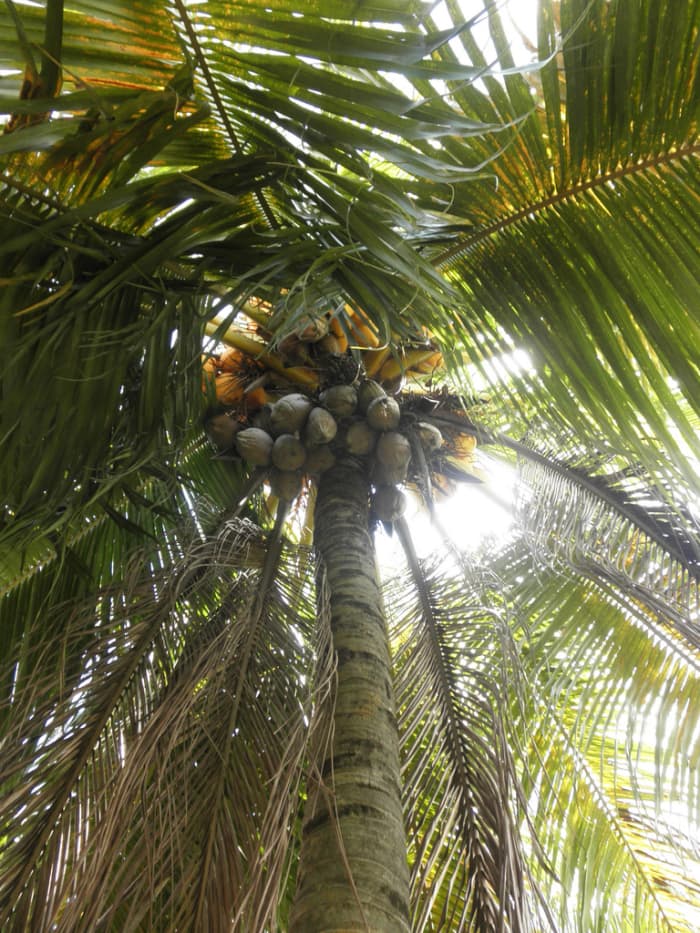 The soil for coconut nut must always remain moist. Allow only a few inches of soil to dry out between waterings. Coconut is afraid of excessive watering and dampness, so for this crop it will be necessary to constantly control the degree of drying of the substrate. The approximate frequency of watering is about 3 times a week in summer and once a week in winter. In summer, abundant watering can be carried out, and from autumn to spring, less water is used.
The soil for coconut nut must always remain moist. Allow only a few inches of soil to dry out between waterings. Coconut is afraid of excessive watering and dampness, so for this crop it will be necessary to constantly control the degree of drying of the substrate. The approximate frequency of watering is about 3 times a week in summer and once a week in winter. In summer, abundant watering can be carried out, and from autumn to spring, less water is used.
But if difficulties with watering are well known to everyone who grows exotics and various beautiful flowering beauties, and they are almost standard for any demanding plant, then the coconut palm will surprise anyone with its intolerance to dry air. This species needs very high humidity levels - from 70% and not lower. Even a slight decrease in these values leads to a loss of decorativeness. And we are talking not only about the dry tips of the leaves of the coconut palm, but the fronds themselves gradually dry out and disappear. And the lower the humidity, the faster the palm tree dies. To create optimal conditions only by spraying, you will have to carry out these procedures not only in the morning and evening, but also up to 5-6 times a day. For a coconut palm, it is better to install large pallets with wet gravel, moss or expanded clay, and even better - to maintain air humidity with special humidifiers.
And the lower the humidity, the faster the palm tree dies. To create optimal conditions only by spraying, you will have to carry out these procedures not only in the morning and evening, but also up to 5-6 times a day. For a coconut palm, it is better to install large pallets with wet gravel, moss or expanded clay, and even better - to maintain air humidity with special humidifiers.
Both spraying and irrigating coconut palms can only use settled, soft and warm water.
Coconut growing at home. © Coco BonsaiNut Coconut Nutrition
The coconut tree needs very specific nutrition. For this plant, it is best not to use fertilizers for ornamental foliage plants or special preparations for palms, but mixtures of fertilizers for bonsai or citrus fruits. Top dressing is applied only during the period of active development with a frequency of 1 time in 2 weeks in summer and 1 time per month in winter (reducing the dose of fertilizers by 2 times). You can refuse winter dressings of the coconut palm, but then the risk of losing decorativeness increases. You can carry out top dressing according to the principle of garden plants: apply fertilizer at the beginning of spring growth, then 2-3 times in summer, and carry out the last top dressing in mid-autumn. But in this case, highly concentrated fertilizers are used, which increases the risk of death.
You can carry out top dressing according to the principle of garden plants: apply fertilizer at the beginning of spring growth, then 2-3 times in summer, and carry out the last top dressing in mid-autumn. But in this case, highly concentrated fertilizers are used, which increases the risk of death.
Coconut pruning
The coconut tree is not shaped, but it still needs periodic cleaning. Dried or damaged leaves are cut off from the plant. But at the same time, you need to be careful: you can only cut completely dry fronds, but only slightly changed color and even half-dry sheets should not be touched.
Transplanting coco and substrate
Coconut does not need frequent repotting. She is afraid of injury to the roots and reacts painfully to changing containers. If you buy an imported palm tree, then it is better to transplant it next spring into a new container (in no case before the end of the period of full adaptation to room conditions and quarantine). But the optimal frequency of transplants is 1 time in 2 years for compact and nut-preserving palm trees, and only as needed, once every 4-6 years for adults. In years when transplantation is not carried out, the top layer of the substrate must be replaced.
In years when transplantation is not carried out, the top layer of the substrate must be replaced.
The substrate for the cultivation of coconut nut is selected from among fibrous, coarse, but very permeable earth mixtures. Suitable ready-made substrates for palm trees. If you are preparing the soil mixture yourself, mix sand, peat, soddy soil, clay, humus and expanded clay or agroperlite in equal parts. A mixture of soddy soil with heather and sand in equal proportions is also suitable.
Coconut palms are not transplanted, but transshipped, trying to avoid even the slightest contact with the roots. You need to be especially careful when taking out the plant: any injury to the taproot, even as a result of a difficult excavation from the previous container, will be fatal. When transplanting a coconut, make sure that the nut is not completely covered: for a palm tree, the same level of deepening is observed that was in the previous container - about half the nut. But a higher planting is not as dangerous as overfilling the nut with the substrate.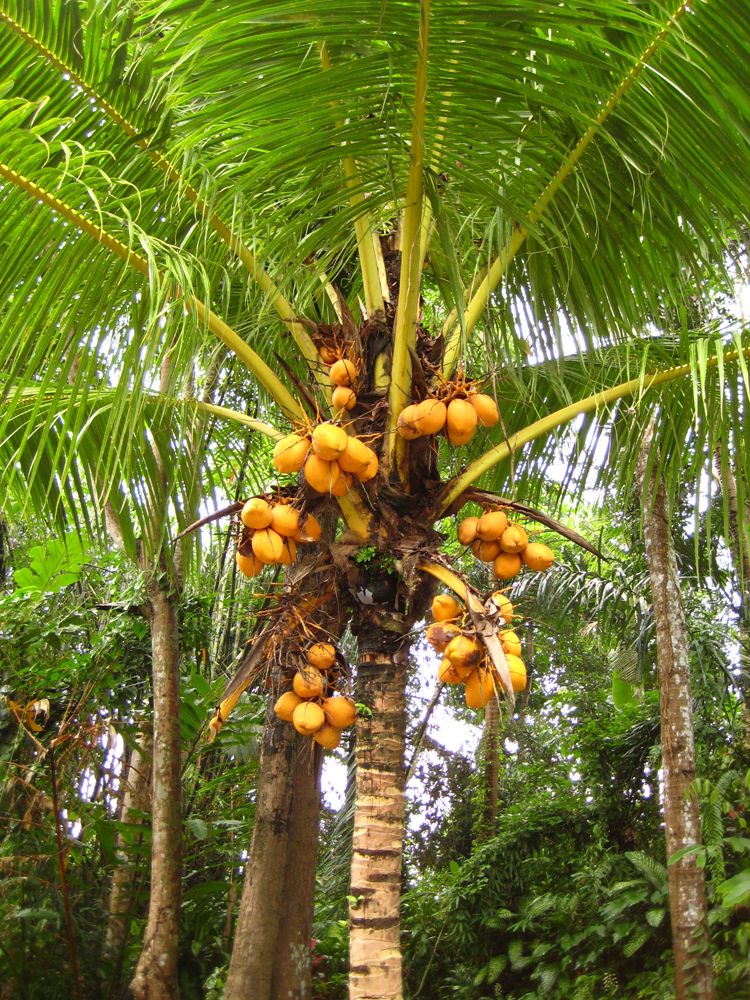 If a palm tree has dropped a nut, we are talking about a very old plant, then the level of deepening is still kept the same. A very high layer of drainage is laid at the bottom of the containers.
If a palm tree has dropped a nut, we are talking about a very old plant, then the level of deepening is still kept the same. A very high layer of drainage is laid at the bottom of the containers.
Coconut palm containers are usually taken quite large, increasing their diameter not by 2-3 cm, but by 4-6 cm, in order to eliminate the need for frequent replanting even at a young age.
Planting a coconut in a sprouting pot. © Z4Devil Coconut sprouting. © Z4Devil A sprouted coconut has opened its first leaves. © Z4DevilDiseases and Pests of the Coconut Palm
In room conditions, two main "enemies" annoy coconut palms - mealybugs and various types of rot. But there are scale insects and spider mites on the palm tree, which are especially active in violation of care in terms of air humidification.
Common growing problems:
- drying tips and leaves due to improper watering or feeding;
- leaf curl during overflow or drought;
- slow growth and lack of new leaves due to improper feeding or need to repot;
- darkening and wilting of leaves in cold weather.
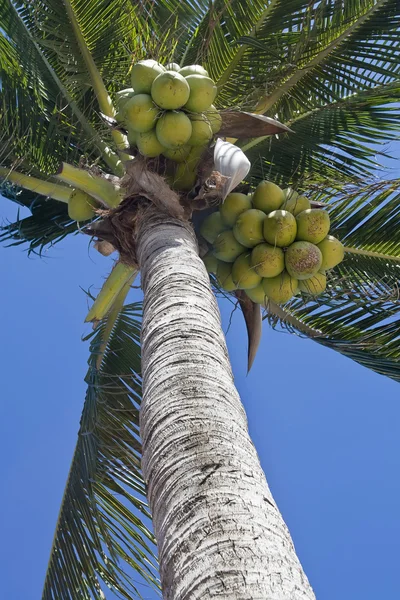
Coconut Palm Propagation
This is one of the most difficult palm trees to propagate and can only be obtained from seeds. But that hasn't stopped many from trying to grow their own coconut tree.
Only mature, ripe and fresh coconuts are used for cultivation. Coconut is germinated in wet peat, without completely deepening the nut, but leaving a “top” on the surface with holes for germination (2-3 points through which the juice is usually drained). Pre-soaking in water from 45 to 80 degrees is welcome, but it does not show much at germination rate.
The container with coconut palm must be covered with glass or film on top, creating greenhouse conditions and traditionally airing it daily. For germination, it is necessary to maintain a stable temperature of 25 degrees Celsius. The process of releasing a single embryo can take up to 5-6 months.
Coconut is transplanted immediately after the appearance of the sprout, deepening the nut less, only up to half. The nut is not separated on its own: gradually, when the need for it disappears, the palm tree will “drop” it itself. And until then, they don’t touch him, but protect him from any contact.
The nut is not separated on its own: gradually, when the need for it disappears, the palm tree will “drop” it itself. And until then, they don’t touch him, but protect him from any contact.
Coconut / plant care
All about plants
- Message from GeoGlass
01 Nov
All about the plant
This palm is the only representative of the Coconut genus. The name comes from the Portuguese word "coco" - a monkey, because on the nut that the tree brings, there are three spots arranged so that their pattern resembles the muzzle of these animals.
The phrase coconut palm brings to mind a tall tree with huge leaves swaying under the sea breeze in hot tropical countries. And few people know that it can be successfully cultivated as a houseplant. A house palm tree can be grown from a nut, but since this is a very long process, flower growers believe that it is better to buy a coconut tree in a store.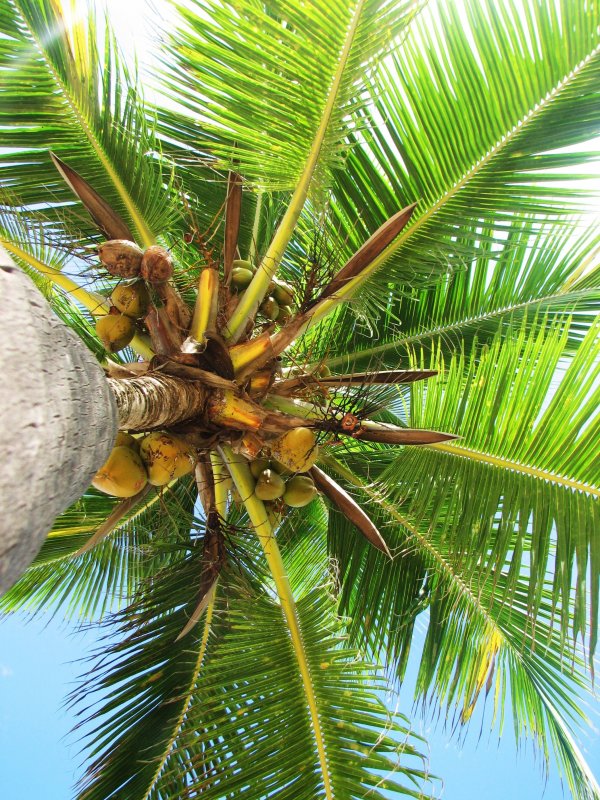
Care of the coconut tree
Air: The palm tree needs fresh air, so the room where it is located must be regularly ventilated. In addition, for the coconut palm, you need to keep the air in the room humid. To solve this problem, you can install a special humidifier or micro-sprinkler.
Lighting: Coconut palms need a place with plenty of light. Therefore, the best location for her will be the southern window sill. But, while the palm tree is young, it must be protected from the direct midday rays of the sun, so at this time the tree needs to be slightly shaded. When the palm tree grows up and gets stronger, the hot rays will no longer be afraid of it. In the dark season, when the daylight hours are short, it is necessary to use plant lighting.
Every 2 weeks the tree pot will need to be turned. If this is not done, then the light will fall only on one side of the palm tree. This is fraught with the fact that the trunk will lean towards the light, and the crown will form asymmetrically.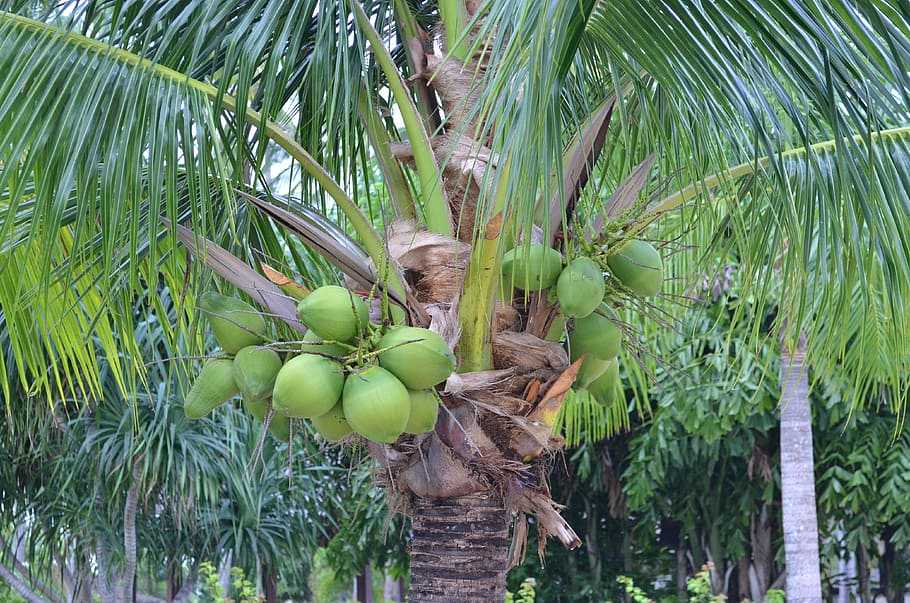
Temperature: It is important that the tree does not suffer from the cold either. The coconut tree likes a fairly high temperature. The optimal mode is + 23-28 ° C. If the temperature drops to +16°C, the tree will stop growing. A palm tree can withstand a short drop to 0 ° C, but, definitely, sub-zero temperatures will destroy it.
Watering: The palm should not be overdried or overwatered. From the beginning of the autumn season until spring, water the plant as the soil in the pot dries out. Use only soft, settled water at room temperature.
Top dressing
The palm tree does not need frequent top dressing, but without them the bottom may lose its decorative appearance. Feeding can be done in one of two ways.
- Place granular fertilizer into the soil substrate in spring. They will dissolve throughout the year, gradually giving nutrients to the soil.
- From April to August, once every three weeks, you need to feed the tree with a special solution for palm trees.

Palm Care Features
It is important to protect the part of the coconut that is above the soil of the pot from rotting. Make sure that it does not get water from watering or spraying.
It is not necessary to specially shape the crown and trim the castings of the palm tree. You should not even remove the yellowing and drying leaves, because the plant takes nutrients from there until they are completely dry. Only such leaves can be removed from the tree.
Reproduction
The palm tree is propagated in two ways - from nuts and shoots. Since only an adult palm tree gives daughter shoots, at home the main method, and, as a rule, the only method of reproduction is seed.
Of course, the nut must be intact, as only filled with liquid can germinate. If such a nut is shaken, you will hear how coconut water splashes inside. One "but" - the nuts that are sold in the store are not suitable for planting.











